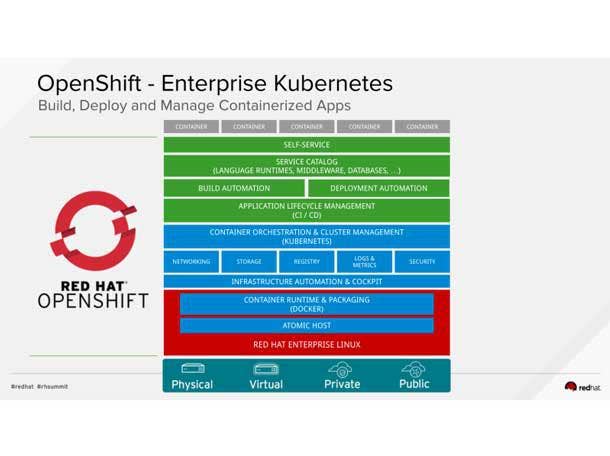Red Hat’s OpenShift 4 Kubernetes Platform: 5 Things To Know
In terms of Red Hat’s emerging products, OpenShift is out in the lead, because it's capitalizing on key trends including hybrid cloud, Kubernetes and containers, and DevOps and cloud-native application development, according to Joe Fernandes, Red Hat’s vice president of products for cloud platforms.

Red Hat unveiled its new enterprise-grade OpenShift 4, its first new major iteration of the Kubernetes platform since it was rebuilt around the open-source container orchestration system four years ago.
OpenShift 4, unveiled at the Red Hat Summit in Boston and expected to be available in the next month, is designed with full-stack automation for a cloud-like experience, allowing developers to run container-based software applications in hybrid cloud environments.
“We put more focus on how people manage the platform and how they manage apps that run on the platform,” said Joe Fernandes, Red Hat’s vice president of products for cloud platforms. “What we're seeing is people are deploying more and more different types of applications, more complex applications, for things like databases or messaging solutions or (artificial intelligence) and machine learning. So as the universe of application workloads expands, people need better tools to manage them, because those apps aren't just simple, cloud-native apps.”
In terms of Red Hat’s emerging products, OpenShift is out in the lead, because it's capitalizing on key trends including hybrid cloud, Kubernetes and containers, and DevOps and cloud-native application development, according to Fernandes.
“These things are in high demand, and OpenShift kind of brings that together,” he said.
Red Hat said it’s almost doubled the number of OpenShift customers to include more than 1,000 enterprises that use it for application development and delivery, including Banco Santander, BMW, BP, Cathay Pacific, Deutsche Bank, Emirates NBD, ExxonMobil, General Electric, Kohl’s and Volkswagen.
What follows are some of the key features of OpenShift 4.
5. Operator Framework
New to OpenShift 4 is single-step installation for Kubernetes applications and services, and automated, over-the-air updates and performance tuning with Kubernetes Operators.
Red Hat last year launched a new upstream project called the Operator Framework, an open-source toolkit designed to manage Kubernetes-native applications, known as Operators, in a more automated and scalable way.
“Operators basically allow you to extend Kubernetes with management capabilities that are specific to the different types of services that you may want to run,” Fernandes said. “We took this Operator concept and said we can apply this both to work with our partners for better managing the stuff that they want to run on top of OpenShift, and then we can use this ourselves to better manage the platform and make it more automated.”
4. Red Hat OpenShift Operator Certification For ISVs
Red Hat introduced Red Hat OpenShift Operator Certification to validate the work of its independent software vendor partners.
“OpenShift 4 is the first time we fully support Operators, and then the certification program kind of layers on top of that feature,” Fernandes said. “The certification is how do we enable partners to take advantage of this feature and jointly certify and support the capabilities that they built with it. The goal of certification is to basically say, even though anybody can take advantage of this technology, we've worked together with select partners to make sure that we got it right and that we're basically addressing the needs of our joint customers.”
3. OpenShift Multi-Cluster Manager
OpenShift Multi-Cluster Manager is part of OpenShift 4 because Red Hat customers typically have more than one OpenShift cluster and, increasingly, are running those clusters in more than one location, according to Fernandes.
“So we've added a new hybrid cluster management capability that allows you to manage multiple clusters, running across multiple clouds or on-premise environments,” Fernandes said.
2. OpenShift Service Mesh
Red Hat is bringing support for Istio in OpenShift 4 through what's called the OpenShift service mesh, which is designed for increased resiliency and performance of distributed applications.
Istio is an open-source project for microservice developers to help them build and debug microservices-based applications, and Red Hat has been heavily involved in the project.
1. Knative Framework
The Knative framework, in developer preview, is a new developer-friendly serverless framework for building, serving and running event-driven applications.
Knative includes scale-to-zero, autoscaling, in-cluster builds and eventing frameworks for developing cloud-native applications on Kubernetes. It allows developers to focus on writing code by hiding complex parts of building, deploying and managing their applications, according to Red Hat.
“Serverless is a key component of function-as-a-service offerings like AWS Lambda or Azure Functions or Google Cloud Functions,” Fernandes said. “This is sort of a new style of programming, basically using functions to add functionality to your applications versus having stuff that runs all the time. We've seen developers really begin to adopt this technology. But the problem is, it's typically available in a specific cloud. We wanted to create something that could work across multiple clouds and also work in the data center.”
“It's in developer preview, so it's not fully supported yet, but it's something that we've been building for the past year, and it’ll be releasing in the next six months or so on top of OpenShift 4,” Fernandes said. “We want to get it into more customers hands and let them play with it and tell us what they think.”